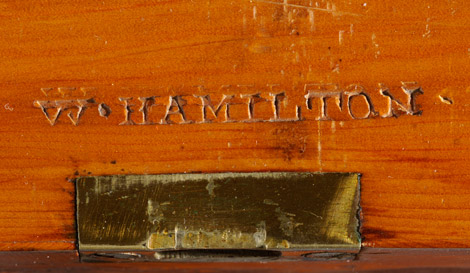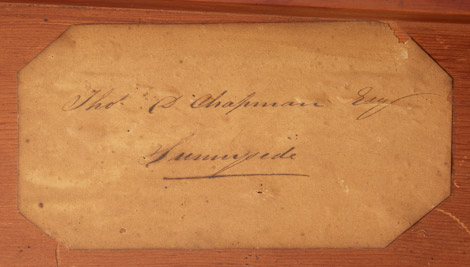Centre or occasional table
Centre or occasional table
c. 1840s
William Hamilton (c. 1796–1885), maker
wood (Huon pine veneer, Huon pine, King Billy pine); metal (brass and steel fittings)
Purchased with the assistance of the Art Foundation of Tasmania,
Friends of the Tasmanian Museum and Art Gallery and the Public Donations Fund, 2009
72.5 h x 80 w x 80 d cm
P2009.64
Provenance
The original owner of the table was Thomas Daniel Chapman (1815–84), born in Bedford, England, and arriving in Tasmania in 1841. The table has a paper delivery label pasted to the underside of the top indicating delivery to Chapman’s house, Sunnyside, in New Town, Tasmania. The table may have been part of the original suite of furniture commissioned for the house.History
The Irish-born furniture maker William Hamilton was one of colonial Tasmania’s most skilled craftsmen and successful businessmen. Born around 1796, he migrated from Ireland to Van Diemen’s Land a free settler in 1832. Hamilton worked as a cabinetmaker in Hobart until 1878. He exhibited furniture at the Great Exhibition of the Works of Industry of All Nations in London in 1851 and at the Inter-colonial Exhibition of Australasia in Melbourne in 1866–67.
The table’s original owner, Thomas Daniel Chapman (1815–84) was born in Bedford, England and joined the East India Company at the age of fourteen. In 1837 he settled in London as a partner with the general merchants John and Stephen Kennard. It was on their behalf that he took emigrants and stores to Circular Head in north-western Tasmania in 1841. Chapman then moved to Hobart Town to act as an agent for the Kennards, married and, in 1847, established the independent firm TD Chapman & Co. The company exported wool, whale oil and timber. They imported groceries, hardware and clothing from Britain, sugar and corks from Mauritius and tea from Ceylon.
Chapman began a long political career as president of the Anti-Transportation League and in 1851 was elected to the Legislative Council where he agitated for self-government for Tasmania. Chapman was instrumental in drafting the colony’s constitution and in 1856 he was elected to its first House of Assembly. Despite periods of financial difficulty and political controversy, Chapman remained active in Tasmanian politics for the rest of his life, dying of bronchitis in 1884.
Chapman’s elegant villa, Sunnyside, was built in the mid 1840s in the Hobart suburb of New Town. Here, it was one of a number of marine villas overlooking New Town Bay, including Runneymede and New Town House. The house was built in the austere Roman Revival style with a single-storey verandah running across the front and a projecting, central portico with paired columns, entablature and pediment.
This classical taste is reflected in the carved acanthus leaves and other motifs used in the decoration of the table. Hamilton’s judgement and skill is evident in both these and other elements of the table’s design and construction. While the design of the table is typical of quality British furniture of the time—it was probably drawn from one or more designs found in the many pattern books published in the early nineteenth century—it was also well adapted to the local material, Huon pine. Details such as the carved collar, the acanthus motifs, the bracket feet and the shaped petal apron appear frequently in pattern book designs throughout the first half of the century. Hamilton has succeeded in combining them into a unified, restrained composition that is well adapted to the wood.
The close grain of Huon pine means that fine and detailed carvings can be executed to a high standard in the straight-grained wood. The carving here is both crisp and well finished. Hamilton kept the flat surfaces plain, enriching them with ornate, highly figured wood. His arrangement of the veneer segments on the tabletop produces a consistent and symmetrical pattern over the whole surface while introducing a second square of pattern that is in the grain itself.
Description
Small centre table with a circular, hinged and tilting top supported on a turned and carved column and circular base with three carved and scrolled feet fitted with castors. The top of the table is circular and veneered with eight matched and mirrored segments of highly figured Huon pine; the edge is cross-banded with a carved petal apron below.
The column is of baluster form. The upper part is faceted and has eight sides; the lower part of the column is carved with four repeating acanthus motifs and rests on a carved collar of six slightly concave ogee petals. The circular base is facetted and veneered with highly figured Huon pine. Supporting it are three scrolling bracket feet with finely carved floral motifs.
Statement of Significance
The Thomas Daniel Chapman occasional table is an example of fashionable drawing room furniture manufactured in Tasmania from local materials to the highest standards of craftsmanship. Its manufacture demonstrates the presence of furniture makers in the colony versed in the crafts of fine cabinet making, carving and veneering. It demonstrates the regard in which Huon pine was held as a furniture timber, used for pieces intended for the best and most public rooms of colonial houses.
The presence of both the maker’s stamp and a label identifying the original owner makes this piece of furniture an important addition to the collection, adding to an index of historical information against which to assess other examples. The table was probably one of a number of pieces commissioned especially for Thomas Chapman’s House, Sunnyside, in New Town, southern Tasmania.
Inscriptions
 Impressed maker's mark on top of pedestal: ‘W. HAMILTON’.
Impressed maker's mark on top of pedestal: ‘W. HAMILTON’.
 Paper label pasted to underside of table, inscribed in black: ‘Thos D Chapman esq / Sunnyside’
Paper label pasted to underside of table, inscribed in black: ‘Thos D Chapman esq / Sunnyside’
References
Fahy K and Simpson A, 1998 Australian Furniture: A Pictorial History and Dictionary 1788—1938, Casuarina Press, Sydney, Australia. p. 445 and pp. 59-60

© 2009 Tasmanian Museum and Art Gallery
This page was last modified on :
1 July, 2010

